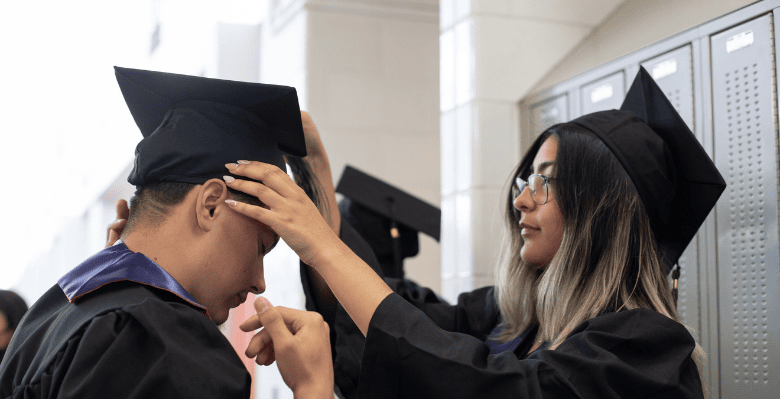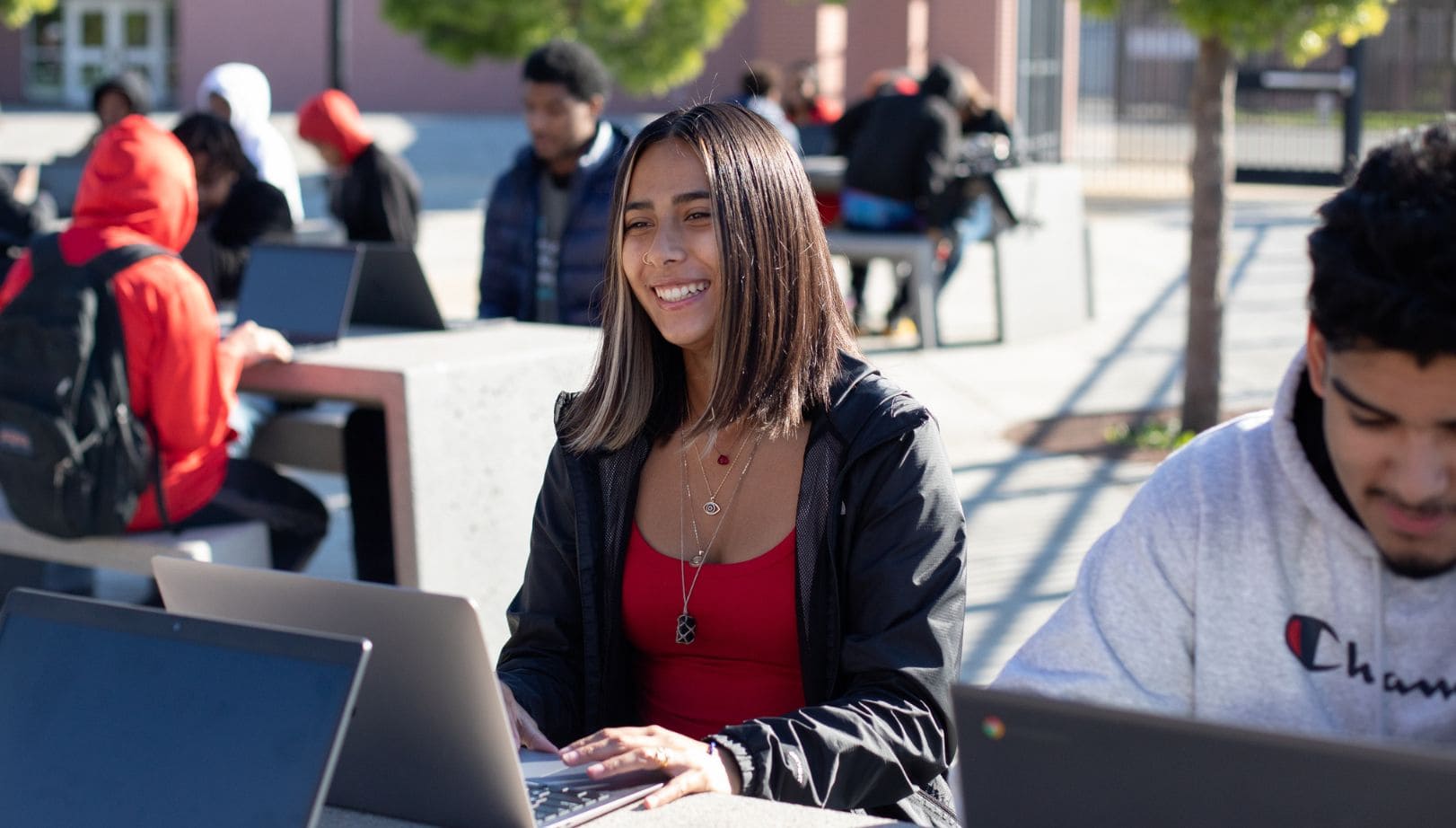Definition
Short-term goals are goals that can be reasonably completed within a year.
By Shelby Ward
March 23, 2024
Motivating students on their postsecondary journey is not just about encouraging them to start, but also empowering them to complete their education. In today’s dynamic educational landscape, motivation plays a pivotal role in determining a student’s success. This blog post explores effective strategies and insights to inspire and support individuals in pursuing and persisting on their postsecondary path, ultimately helping them achieve their academic and career goals.
When a student graduates from high school, they are embarking on a new path. Unlike their previous years, this path is not planned out, and students must take many new steps. Students must have continued motivation in order to be successful when facing difficulties such as classes, financial strain, and other unfamiliar situations. Success on the postsecondary path requires motivation that starts in high school. This blog will explore ways parents, teachers, and other school staff can motivate students to successfully move through their postsecondary path from high school to a meaningful career.

Students must create clear and achievable goals for their postsecondary journey. By setting clear goals, students will have something to focus on when the path is challenging. Studying for a test, working a few extra hours to pay tuition, or putting up with roommates can be frustrating in the short term, but a student focused on an end goal of their dream job will be more likely to push through the minor obstacles. Goals should also be achievable. If a student cannot successfully complete the goals they set for themselves, they are more likely to become discouraged.
Students should set a variety of goals, both long-term and short-term.
Definition
Short-term goals are goals that can be reasonably completed within a year.
Examples
Benefits
Short-term goals give students the satisfaction of completing something. Even completing a minor goal can cause students to feel accomplished and give them a motivation boost.
Definition
Long-term goals are goals that take more time to complete. Students can set multiple short-term goals that build up to a specific long-term goal.
Examples
Benefits
Long-term goals help students see the bigger picture. Instead of focusing on short-term struggles, students can instead think about how great it will be to achieve their long-term goals.

One of the most important long-term goals that students must set is which career they plan to pursue. Just like with other goals, a student’s career goal must be clear and achievable.
To ensure that they are picking a successful career, students should have opportunities to explore different careers through job exploration fairs, career presentations, and other career exploration opportunities.
In Houston, Texas, OneGoal has partnered with BridgeYear to bring career exploration fairs to various high schools. These fairs expand on a traditional job fair by allowing students to actually try out different careers such as plumbing and phlebotomy. This is a great way for students to discover various careers that they may not have considered before.
Beyond career exploration, schools should prioritize advising for students. Students need the opportunity to sit down with counselors or career experts to discuss college and career options.
Once students have determined which career they are interested in, they need to examine the steps to achieve their goals. This is a great opportunity to set short-term goals. Schools could provide time during a home room or study hall to have teachers meet with students for brief progress checks or conversations. Meeting regularly with a caring teacher will give students more opportunities to discuss concerns and aspirations.
As part of the OneGoal program, students have several chances each quarter to meet individually with their Program Directors to discuss their career aspirations. Before the meeting, students are asked to complete a survey that gives the Program Director an update on the students’ progress as well as any personal updates and questions. This gives the Program Director an opportunity to prepare for the meeting and research information that will help the student. As Program Directors meet with students, they keep notes about their meetings in order to keep a record of student goals and progress.
Schools should also incorporate goal tracking. They should be accessible to both students and educators. They can be utilized during discussions between students and advisors, as well as in between meetings for students to regularly update their progress.
There are many different ways that schools could set up these trackers. Students could simply be given a shared spreadsheet (such as in Google Sheets or Microsoft Excel). The spreadsheet should have a place to write goals, a place for updates from the student, and a place for feedback from the teacher. Other options include a shared Google Doc or Microsoft Word file, surveys, or even a traditional notebook or binder stored in a safe, preferably central location.
One tracking tool used by students in the OneGoal program is the Best Fit List. This is a list that students compile regarding the colleges that they are interested in attending. Students use this tool to set goals for the types of institutions they’d like to attend, including goals regarding the SAT/ACT scores and GPA.

Many teachers find they can motivate students by giving out rewards such as candy, extra credit, and even small toys. Those are examples of extrinsic motivators. Any motivation that comes from outside a person can be classified as an extrinsic motivator. Additional examples include pleasing parents and teachers, good grades, and even a high salary.
Such methods can be extremely effective in the classroom, but what about when the student leaves the classroom? Once a student begins their postsecondary path, many extrinsic motivators either disappear or lose their effectiveness. In college, very few professors offer candy, extra credit, or toys! In bigger college classes, most students will not feel compelled to impress professors who may not even know their name. While grades and the honor roll do matter in college, they are often not a big enough motivator in the face of a difficult course load. Even a high paying job that does not bring personal satisfaction will likely lose its appeal. Students who rely only on extrinsic motivators may struggle to complete their postsecondary path.
In contrast, intrinsic motivation is motivation that comes from within a student. It is the desire to do well because they want to do well. It is a personal pleasure in achieving and completing work. Students who have developed a high level of intrinsic motivation are much more likely to complete their degrees or certifications and move on to a meaningful career.
While extrinsic motivation should not be the only motivation that students have, it does have many benefits in fostering intrinsic motivation. For example, a student who only completes work for the grade may realize that they like the feeling of accomplishment that accompanies the hard work.
It is great to use extrinsic motivation to help students develop intrinsic motivation. Teachers should take time to help students recognize the internal satisfaction that comes with the extrinsic reward.

Students who are working towards a career in a field that excites them and brings personal satisfaction will have an easier time developing intrinsic motivation for completing their degree or certification in the field. By using some of the suggestions for career exploration discussed above and in our blog post, 5 Creative Ideas to Emphasize College and Career Readiness, teachers can help students find a career they will enjoy every day and not just payday!
Let students create! Give them opportunities to create rather than just completing worksheets. This will give them something of which they can be proud. If possible, find a way to share their creations with parents. Students can create their own portfolio website showcasing their work that can easily be shared with parents. Other projects include a vision board, a slideshow, an illustrated biography, or a student-created film.
One of the most frustrating questions teachers get is “When will I ever use this?” Students who do not feel like their learning is useful beyond the classroom may not care enough to learn it. Showing students how what they’re learning in school relates to the real world will not only increase intrinsic motivation for the current lesson, but also teach students how to connect classroom learning to real life in the future.

Preparing to embark on a postsecondary path is often frightening for students, especially first-generation college students. Many of the forms and applications that need to be completed are complicated and can be frustrating. Parents, mentors, and teachers must work together to ensure their students are being set up for success at the beginning of the path.
Teachers and other adults involved in education are uniquely situated to help students. Veteran teachers helped previous students complete forms. New teachers can talk to other teachers and coworkers. If the school has a study hall or homeroom, then time during that class can be devoted to completing forms such as FAFSA and college applications.
Schools could also implement a program for teachers to mentor specific students. Davis High School in Houston asked teachers to “adopt” five seniors this school year. The teacher is responsible for checking in with their seniors on a regular basis. They are asked to make sure seniors are completing their FAFSA and applying for trade schools. This extra support by a teacher ensures that seniors are not being left behind because they did not know about the application process.
Whenever possible, the school should host an event for parents to come and get help completing forms. Schools should have language support available for parents for whom English is not the primary language.
During high school, parents and guardians are needed to complete the FAFSA. Parents who are unfamiliar with the process can reach out to their student’s school for assistance. Read our blog post “A Guide to the New Better FAFSA: Everything You Need to Know” to learn about the new Better FAFSA.
Beyond filling out forms, parents and other adults should talk to their students regularly about their goals, especially college and career goals. They should communicate regularly with the school about what resources they need to support their students.
As students graduate from high school, parents and other trusted adults are a vital part of the support system that students need to persevere through their postsecondary path. Unlike most teachers, these adults are part of the student’s life after high school and can be a listening ear for a student who is feeling discouraged. Parents and other adults should check in with their students to see how they are progressing in school. Whether or not a parent has college experience, they can still be there to support their student and empower success.
Sometimes, it seems like only the big achievements such as graduation are worth celebrating. However, any achievement—big or small—should be marked with some recognition. By celebrating their achievements, students will begin to recognize and feel proud of their own accomplishments.
Make a display showing how much money students have been offered by scholarships. This can be done for a combined class total, individual students, or both! One fun way to do this is to make signs that look like checks. The teacher can display them around the classroom. This will motivate students to apply for more scholarships.
Hold a brief celebration and announcement at the beginning of class on certain days to celebrate any students who have been accepted by a college, university, or trade school. Play some fun music and let the students celebrate each other.
Make a display of the United States and allow students to place a pin or sticker for any college to which they have been accepted. For the local area, the teacher may want to make a separate display that will allow students to be more precise on their placement. Once students pick a college to attend, they could place a special pin or sticker for that school. The teacher should be excited and take pictures of the students. The teacher could even pretend to be the paparazzi or a reporter for an added twist.
Have students line up at the front of the room and present them their certificates and let them be applauded. If finances allow, a small treat with the certificates might increase the fun for the students.
Have the students stand up at the beginning of class and their fellow students cheer for them. Play the school song or show a video of the event if one is available. This has the added benefit of increasing school spirit.
Take time at the beginning of class on Mondays or after a break and let students report on anything positive they have experienced. Teachers could also make a poster or use a website such as Padlet to let students write their own achievements.

Students must be motivated to complete their postsecondary path. By setting goals, cultivating intrinsic motivation, providing support and resources, and celebrating milestones and achievements, educators, parents, and students can work together to motivate students to pursue and complete their postsecondary path, leading to a brighter future.
Shelby Ward was born and raised in Spokane, Washington. She received her BA in history teaching from Brigham Young University in Provo, Utah, where she had the opportunity to move to Houston for a three-month internship. Despite experiencing her first hurricane 10 days after moving in, Shelby never left and is now a OneGoal Program Director in Houston.

College and career readiness is a frequently used metric in schools and in the postsecondary access field. But how is readiness defined? And what steps can schools take to help pave the way?
Each summer, 10% to 40% of high school students intend to enroll in college the fall after graduation but never actually do so.
How can we match students with colleges and other pathways that align with their personal and professional goals? Which institutions are supporting the social-emotional needs of students?